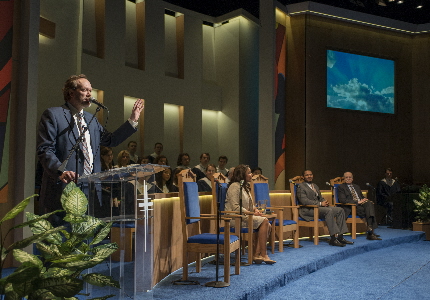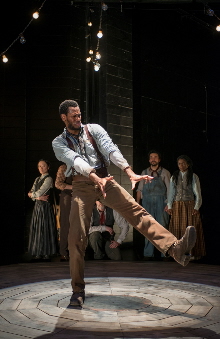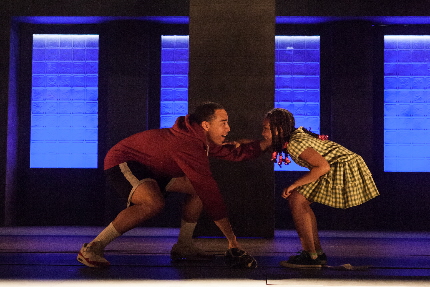
The audience receives a startling sermon from Pastor Paul in Lucas Hnath’s new play The Christians at Actors Theatre of Louisville’s Humana Festival of New Plays / Photos by Michael Brosilow
By Bill Hirschman
If you’re seeking safe, predictable mainstream theater, or what passes today for mainstream, avoid the annual Humana Festival of New Plays at the Actors Theatre of Louisville.
On the other hand, if you’re seeking that Holy Grail of “thought-provoking, edgy new work” you’ve never seen nor likely imagined before, the annual gathering on the banks of the Ohio River is a mecca for those who want to glimpse what theater is evolving into during the coming decades.
What distinguishes the 38th festival just ended last weekend from similar forays in South Florida are large budgets, an unusually receptive audience measuring in the thousands and a convergence of some of the most talented theater artists in the country.
That doesn’t mean every undertaking worked or connected with every patron. In fact, each work split the reaction of the audience like the watershed along the Continental Divide.
These were first productions and, as playwright Lauren Gunderson observed in a keynote address that week, the play development paradigm has changed. Rarely is a play “ready” in the traditional Broadway sense until after it has been revised for the opening of its second production, if then. It’s a lesson that local audience members learned watching new work at the late Florida Stage.
Actors Theatre, celebrating its 50th anniversary this year as a ground-breaking regional theater, and its slightly younger Humana Festival have built a reputation as the developer of 400 new works. Many have gone on to international and prize-winning futures such as Crimes of the Heart, The Gin Game, Getting Out and Dinner With Friends. Its other major initiative finding short plays was at one time a source for City Theatre’s Summer Shorts. The festival plays are cycled in over a six-week period culminating in two weekends attended by fans, critics and industry leaders who participate in panel discussions and intensive networking.
One facet of the festival that must be underscored is that even when the scripts are still gelling, all of the acting, directing and design elements are never less than stunning. You have likely never heard of most of the actors, directors or creative staff (most from New York, Los Angeles and Chicago) but they prove that America is awash in an embarrassment of skilled, trained talent. These are people who are not household names headlining Broadway productions but who are ensuring that the quality of theater in this country takes a back seat to no one’s.
Some of this year’s crop of plays called out to be produced in South Florida in coming seasons. Additionally, the festival hosted the presentation of the Steinberg/American Theatre Critics Association’s new play awards, although those works were not staged in Louisville. One citation winner was familiar to South Florida audiences: Christopher Demos-Brown for Fear Up Harsh debuting at Zoetic Stage in Miami. But the three other award recipients offered promising options for local productions.
Among the most intriguing offerings from the festival itself examined the inflexibility of organized religion, the difficulty of maintaining relationships under the weight of new found money, the American need to make myths, and an affecting analysis of a senseless street killing.
While stylized staging bordering on performance art was a hallmark of several pieces, others echoed naturalism and seemed like second cousins to conventional theater.
A favorite theme or at least subtheme was the ineffectiveness of human speech as a means of communication. Playwrights kept pushing at the boundaries of what constitutes stage dialogue. In a heightened vision of everyday speech, characters started sentences but did not finish them, their thoughts dying as the words hit the air. Other times, people talked at and through each other without being truly heard,
The other major theme running through several of the works was Americans’ addiction to storytelling whether it was a preacher recounting anecdotes for his flock or 19th century neighbors passing an evening around the fire with singing folksongs or interviewees recounting the run-up to a murder.
Gimme That Ol’ Time Religion
For instance, The Christians by Lucas Hnath was perhaps the piece most intellectually-appreciated by the audiences although more than a few people found a few plot turns hard to swallow. In it, well-coiffed affable Pastor Paul, familiar from a dozen TV channels, is sermonizing at the mortgage-burning for his sleek mega-church accented with blond wood, royal blue carpet and multimedia equipment.
For at least 20 minutes, he speaks directly to us as surrogates for his congregation as he recounts an epiphany at a recent pastors’ convention. It sounds as if he is about to reaffirm traditional Christian dogma that you must accept Jesus as your savior or burn in Hell for eternity regardless of your good deeds. Then suddenly, in a surprise to everyone including his wife, he announces that he cannot believe that the God of love would impose eternal damnation on decent altruistic people whose lives’ mirror His tenets. He rejects the existence of Satan and even Hell itself.
For the rest of the play occurring on the church’s dais, his adherents fall away: an associate pastor starts a competing church, hundreds of parishioners desert including the large choir singing behind him, then the church elders defect and finally his wife who he had not consulted about his doubts nor his plan to announce it to the church.
While liberal-minded audiences may side with the pastor after he reveals his humanistic revelation, some of his opponents legitimately question the purity of how and when he revealed his change of heart – as well as its incompatibility with what his branch of organized religion has taught for nearly 2000 years. They accuse him of a go-it-alone-arrogance and a hubris. He believed his charismatic leadership would carry the congregation to a new theological place. Perhaps he did not tell his wife because he knew what she would say. Instead, he has martyred himself and everything he has built. Hnath, who looks like a counter-culture creature but grew up in just such a church in Orlando, is raising questions not answers.
Other than a needless affectation of every character speaking into a hand-held microphone, the staging by Louisville’s Artistic Director Les Waters is simple but effective and he elicits three-dimensional performances that ring true. Especially credible is actor Andrew Garman who has the cadences of a preacher down cold. He speaks low, warming almost whispering tones into a microphone held an inch from his mouth. Garman’s pastor, indeed, captures that mixture of genuine altruistic fervor and that annoying certainty that God is whispering in his ear.
Hnath, who won an ATCA citation last year for Death Tax, is quickly becoming one of the busier young playwrights in the country with multiple commissions pending and multiple productions of his works already scheduled. Watch for The Christians to pop up everywhere, although it requires five actors and benefits immeasurably from a gospel choir in full voice plus a set that looks like the church has some wealthy donors behind it.
Hammer Head
The most divisive piece was Steel Hammer, a highly stylized meld of dialogue, choral speaking, mime, monologues, dance, movement, music, lighting, sound and most stagecraft disciplines. This two-hour contemplation of national mythmaking was centered around the truth and the tall tale fiction behind folk song hero John Henry.
The multi-faceted piece was collaboratively created by the avant-garde darlings of New York City, the SITI Company. Multiple playwrights, composers, musicians and the entire acting company worked under the direction of legendary visionary Anne Bogart.
Most observers were enraptured, enraged or bored to tears over this work, sometimes all of the above. In trying to put the audience in the soul-eroded situation of the title character, SITI relied heavily, as in aircraft tonnage heavy, on repetition. In one truly excruciating passage, six actors chased each other around a circle in various configurations for what felt like 10 solid stolid minutes accompanied by music that sounded like a cross between Enya and Phillip Glass.
The work was a procession of “scenes” in different theatrical modes and told from different points of view. Americans sitting in a circle tell the story of the famed African-American laborer who died in a race with a machine to drive holes in a railroad tunnel for explosives. The piece underscores not just the love of storytelling, but Americans’ need to fictionalize tales to create myths that ennoble and validate establishment values.
Many acknowledged its outstanding virtues, such as the stunning visual tableaus, choreographed movement including body percussion, and the impassioned, committed performances, especially that of Eric Berryman as John Henry. But at the same time, many of the same people were ready to slit their wrists as the play droned on and on and on, intentionally set by Bogart at a pace that felt like the cast were ghosts moving under water with chains on, at least an hour longer than it needed to be to get its message across.
Bogart is clearly a genius, but like Julie Taymor, she desperately needs someone less enamored of her vision to point out that she is literally abusing the audience – assuming she cares, which I suspect she does not. This is art that doesn’t care if it communicates with the audience; it just “is what it is.” Despite shafts of incandescent brilliance, the adjective that came to mind was self-indulgent. There’s a lesson here for some South Florida artists.
Living And Dying In The City
brownsville song (b-side for tray), with its precious lack of capitalization and an opaque phrase, may not sound promising before the play begins. But Kimber Lee’s meditation of violence and families was arguably the most affecting evening of the festival.
Lee, an Asian-American raised in Idaho, nevertheless produced a riveting and excoriating exploration of the lead-up and fallout from a gang killing in the primarily African-American Brownsville section of Brooklyn. Director Meredith McDonough, associate artistic director of the theater, employed inventive theatrical staging and aided the cast in ripping the guts out of Lee’s finely-crafted script.
That’s an apt metaphor reflected in the very first scene as a grandmother, Lena, fiercely tells the audience in a monologue how the senseless murder of her grandson Tray has scraped out the marrow from her bones and her soul. Clearly a strong woman who hates exposing her sorrow, Lena weeps as she explains that Tray was not a gang member, but a high school student who was using his varsity sports skills as a way to get into college. Above all, she does not want him to be a transitory headline or worse just a statistic. This was a human being who mattered, as all do.
Lee sends us back and forth in time as we see disjointed scenes of Lena, Tray and his beloved but deeply withdrawn younger sister, Devine, in passages of family harmony. Lena is a crusty container of tough love. Tray is a normal kid delaying writing a college essay. Devine is indescribably cute as she preps for a small part in a school pageant. As if walking us through a mystery, Lee parcels out crucial bits of previously undisclosed information piece by piece until the total tragedy falls into sharp focus by the finale.
This isn’t a sanitized view of black life in the ghetto simply amped up by a propulsive rap soundtrack. Each character fights down panic anytime someone is late coming home, when someone forgets to pick up Devine after school. The patriarch was also murdered. His second wife, an alcoholic Asian-American named Merrell, could not cope with Devine’s birth and abandoned Devine near a dumpster. And now Merrell has come back into their lives, partly by accident and partly hoping to rejoin the family.
All this may sound a bit soapy, even hackneyed in its familiarity of plot, characters and resolution of redemptive forgiveness. But in execution, it’s heartbreaking to watch because Lee invests us in the lives of these particular people who have universal dreams and motivations. Additionally the cast, especially Cherene Snow as the grandmother, inhabit their characters with a sense of truth that transcends the stereotypes.
McDonough creates wonderful images that embody the kind of self-conscious but expressive direction that is rare in South Florida. In one simple but inspired moment, Lee writes Tray and Devine playing catch with a Nerf football. But the incident is happening in Devine’s post-killing memory. McDonough has Tray take a step back with each toss of the football as you normally would. But as we watch Devine preparing to toss it once more, Tray has quietly slipped offstage, and with the next lob, the ball falls to the ground.
Lee’s structure is well-executed as a smooth steady elegy that is compelling even as you know what is coming, perhaps because you know what is coming. But it’s her dialogue, referenced earlier in this piece, that is especially skillful. Characters often do not complete their sentences aloud because the other characters know what they are going to say or they realize mid-sentence that words are just frustratingly insufficient. And while Lee has spent time in urban environments, her collection of poetical street slang seems bottomless.
Money Is The Root Of All…
The most conventional but equally well-received play – the one almost certain to play in our backyard – was Partners by Dorothy Fortenberry. This wry but penetrating play looks at two sets of late-20s friends who wrestle with what we expect relationships should be in the 21st Century. The first couple are ultra-liberals Clare, an aspiring chef, married to Paul, a techie for a law firm. Her best friend and business partner in a planned food truck business is the witty enchanting Ezra whose romantic partner is the warm and steadier Brady, a schoolteacher.
In a succession of food-infused get togethers at Clare and Paul’s modest Brooklyn apartment, we see the genuine affection among all four through long passages of camaraderie and witty rejoinders. Their backstory, individual quirks, neuroses and goals are feathered in by Fortenberry. The only minor friction is that all four are just getting by financially and Clare is dragging her feet on the logistics of the food truck project.
To a large degree, the play is about relationships among Millenials, especially the nature of marriage. For instance, at Clare’s strong urging, Ezra and Brady are considering marriage, but Brady is a realist. He knows that his physical needs are too strong to promise Ezra not to have mindless sex with other people, and that’s something that Ezra not only can’t understand but can’t abide.
But Clare’s relationship with Paul and Ezra both are strained when she suddenly comes into a $200,000 product liability settlement – not a massive amount but enough to change their lives. It does, but not the way they think when (in the play’s weird left turn), she donates most of it to marriage equality movement. In fact, it puts immense pressure on the tiny but crucial cracks in the foundations of the relationships. It is the nature of those previously nearly invisible cracks (or at least not harped-upon cracks) that most interest Fortenberry.
And Then They Wrote
Almost all of the pieces reflected the mid-30s sensibility of the playwrights to a degree that we hadn’t seen much in mainstream productions in South Florida during the past decade other than Mad Cat Theatre Company. But this more timely reflection of our times is gaining traction with works by Thinking Cap Theatre, Island City Stage, Kutumba Theatre Project and some of the work by New Theatre.
Among such entries at Humana was Jordan Harrison’s The Grown-Up in which a 10-year-old uses a magical doorknob to visit different stages of his life in a more linear echoing of Slaughterhouse Five. This one needed a lot more clarifying but its gleefully irreverent tone and comic book sci-fi sensibility was infectious.
Among the shorter plays and skits were two that were far better polished than many we see in most local festivals. One was a moving monologue, Some Prepared Remarks (A History In Speech) by Jason Gray Platt. In it, actor Bruce McKenzie portrays a person delivering a series of speeches from notes in front of him – each reflecting a different stage of his life from childhood to retirement. The piece embraced Our Town-like universally recognizable moments such as a wedding toast. The role is a plum as the actor morphs with no warning from one stage to the next, demarcated only by him dropping one set of notes (post-its, colored construction paper, index cards, etc.) and pulling out another.
Another shorts winner was Poor Shem by Gregory Hischak, a deadpan drollery about three office drones discovering that their copy machine is on the fritz because a colleague has been eaten by the device.
We have mentioned the Steinberg and Osborn Award winners before in stories about Demos-Brown winning a citation. But the others deserve another mention as potential works for local companies: Seven Spots on the Sun by Martin Zimmerman, Gunderson’s I and You which will be mounted at Arts Garage in January, and Topher Payne’s Perfect Arrangement. See read more about these, click here and here.
To see a video of Demos-Brown accepting his award, click here.
Exhilarating, exasperating but always invigorating, this year’s Humana Festival only whets the appetite for a return trip next spring.











 A PaperStreet Web Design
A PaperStreet Web Design
